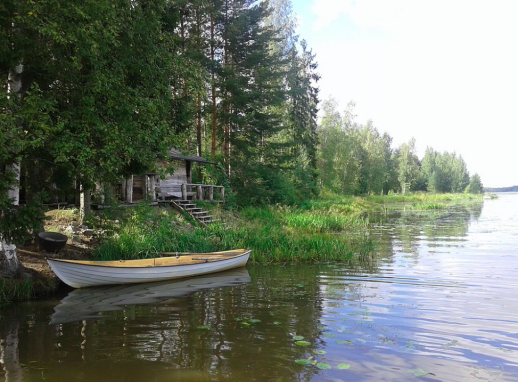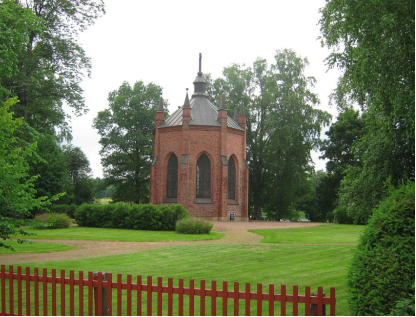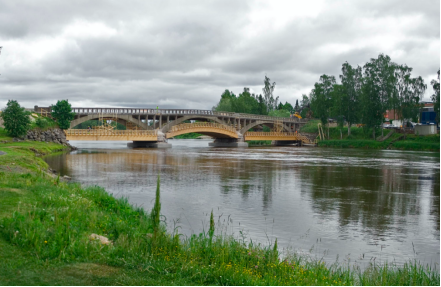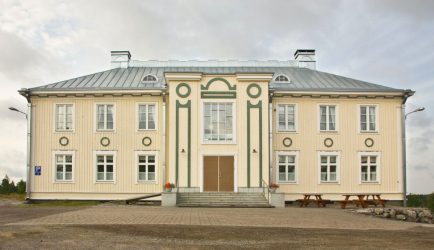Kokemäki 作者: 来源: 发布时间:2021-10-15
一、所属省或是州,具体位置,人口,面积
Kokemäki is a town and municipality in the Satakunta Region of Finland. The town has a population of 7,226 (31 January 2019) and covers an area of 531.27 square kilometres (205.12 sq mi) of which 50.04 km2 (19.32 sq mi) is water. The population density is 15.02 inhabitants per square kilometre (38.9/sq mi).
The 121kilometre long Kokemäenjoki river flows from Lake Liekovesi, in the Pirkanmaa region, through Kokemäki and in to the Gulf of Bothnia at Pori. The Kolsi hydro-electric power plant is located at Kokemäki. Kokemäenjoki has long been an important waterway, well known for its salmon, whitefish and lamprey.
According to the town's official website, Kokemäki was granted a town charter in 1869. The municipality of Kauvatsa was merged with Kokemäki in 1969. Kokemäki was granted city status in 1977.

二、自然地理
1.地理条件
The most characteristic feature of the Kokemäki landscape is the Kokemäenjoki river flowing through the city. To the southeast, on the border of Huittinen, the river is divided into Kyttälänhaara and Kiettareenhaara, between which is Kiettareenluoto. At the former Kyttälä railway station, the river forms numerous tributaries, which again converge below the former Pahakoski and Niskakoski. After this, the river flows northwest in the valley formed by Säpilänniemi and the moraine ridges to its northeast, turns almost backwards in its direction at the tip of the headland and follows the southwestern side of the headland. The fall of the river for 26 kilometers from the mouth of the Loimijoki River to the Kols power plant is only 60 centimeters, but at the power plant the fall height is as much as 12.5 meters. From the interpreter in the direction of Pori, the river flows into the sand and clay plain in its channel.
From its southwest corner, the Kokemäki area is in the Satakunta sandstone area. From Harjavalta to Peipohja, the Kokemäenjoki valley forms the boundary of the area against the bedrock. From Peipohja, this border turns south towards Köyliönjärvi and Pyhäjärvi. The highest terrain in this area is Järilänvuori, which extends 70 meters above sea level. To the northeast of Kynsikangas, Säpilänharju and Ronkankangas, the terrain is rougher and poorly cultivated compared to the plateau in the central part of the city. Near the Huittinen border are the large Korkeasuo, Kiettareensuo and Ronkansuo. Near the Tulkkila River, the Sonnilanjoki River flows southeast into the Kokemäenjoki River, which originates in the forest and marshlands of the eastern part of the former municipality of Köyliö.
In the area of the former municipality of Kauvatsa, the majority of settlements and cultivations are located on a narrow strip south-east of Sääksjärvi towards Puurijärvi. To the northeast of the church village of Kauvatsa, near the border with Sastamala, are the highest peaks in the Kokemäki area, which extend more than 100 meters above sea level.
The largest lake in Kokemäki is Sääksjärvi, which used to belong mostly to the municipality of Kauvatsa. The Piilijoki River, which comes from Kiikoisjärvi on the Sastamala side, and the Rukajoki River, which originates in the eastern part of the former municipality of Kulla, flow into the eastern end of the lake. Sääksjärvi flows down the Kauvatsanjoki River to Puurijärvi, which in turn descends from its southern end to the Kokemäenjoki River. Other lakes are Lake Pitkäjärvi in the south near the Säkylä border and Lake Lievijärvi in the northeast of the church village of Kauvatsa.
At the end of 2017, Kokemäki had 7,381 inhabitants, of which 4,340 lived in agglomerations, 2,954 in sparsely populated areas and the coordinates of the place of residence of 87 inhabitants were unknown. The degree of agglomeration is calculated for those residents whose coordinates of residence are known; The degree of agglomeration in Kokemäki is 59.5%. The population of the Kokemäki agglomeration belongs to only one agglomeration, ie the central agglomeration of Kokemäki, which had 4,340 inhabitants at the end of 2017.
2.交通情况
The transport system of Finland is well-developed with an extensive road system.
Road
Highway 2 passes to the south, running from Helsinki to Pori on the Baltic coast. Highway 12 runs from Rauma to Tampere and Nokia, passing through nearby Huittinen. Helsinki is 205 km or two and a half hours away by car. According to Open Charge Map, there are two electric vehicle (EV) charging points in Kokemäki with another 55 within a 160 kilometre radius. The private coach companies OnniBus and ExpressBus operate services to all major towns and regions in Finland.
Rail
Finnish trains have a reputation for being spacious, comfortable and clean. The state-owned rail company VR operates a service between Tampere and Pori, stopping at Kokemäki. The train station is 3 km to the west of the town centre at Peipohja.
Air
The nearest airport is Pori Airport, which is 43 km or 40 minutes away by Highway 2. Tampere-Pirkkala Airport is 96 km or an hour and ten minutes away by Highway 12. Helsinki-Vantaa Airport is two hours and twenty minutes away by Highway 2.
三、经济发展和规模
There are currently more than 400 companies operating in Kokemäki. The graphics industry, the metal industry and the transport industry are key industries in the area. Agriculture (including the cultivation of special crops) and, most recently, welfare services are also strongly represented in Kokemäki.
The name of the employer is followed by the number of employees:
City of Kokemäki, 320
Lehtosen Konepaja Oy (manufacture of fabricated metal products), 140
Peiron Oy (metal casting), 125
Cemt-Trans Oy, 110
Keski-Satakunta Health Care Consortium, 82
Sinituote Oy, 80
Kokemäenjoki Valley Vocational School, 70
Kokemäki District Office, 51 (66)
Sasky, Kokemäki, 50
Finnamyl Oy (potato starch industry), 25 (66)
Satakunta Tax Office Kokemäki office, 23 (30)
The Kihlakunnanvirasto, KELA (open two days a week), the road master district branch office, VR Kokemäki station, Avena Siilot Oy's grain warehouse and the Kokemäki office of the Satakunta tax district are all located in Kokemäki city center.
Financial and debt counseling is a statutory, free service for customers. Counselors provide information on various support services and debt settlement tools, as well as help in mapping the debt situation and negotiating with creditors. They also assist in a debt settlement case brought to court. Kokemäki is part of the City of Pori's financial and debt counseling office.
https://kokemaki.fi/sosiaali-ja-terveyspalvelut/suunnitelmat-ja-maksut/
https://kokemaki.fi/wp-content/uploads/2020/02/ikäpoliittinen-ohjelma-päivitys-2019-vahvistettu.pdf
四、产业特点/重点项目
Kokemäki has a racecourse known for its Midsummer raves. Other recreational opportunities include a swimming pool, Pitkäjärvi leisure center, Vocational College ball hall, Haapahuhta riding stable, Risten JM and Motocross track, Järilä FK track, Järilä ski center, Piikajärvi airport and the ice rink Teljä Arena. New projects include a golf course on Pitkäjärvi and a central park by Tulkkilantie.
Section 5 of the Elderly Services Act obliges the municipality to draw up a plan to support the elderly population, the plan must be part of the municipal strategy
• The age policy program serves as a tool and anticipation tool for officials and trustees in planning activities and finances
• The age policy program has been prepared in accordance with the quality recommendation for the elderly
• The driving force of the whole program is the involvement of the elderly, opinions on the customer policy boards and the elderly council have been asked for the age policy program.
• The age program is updated annually when the budget is drawn up
https://kokemaki.fi/sosiaali-ja-terveyspalvelut/suunnitelmat-ja-maksut/
https://kokemaki.fi/wp-content/uploads/2020/02/ikäpoliittinen-ohjelma-päivitys-2019-vahvistettu.pdf
https://kokemaki.fi/wp-content/uploads/2020/06/Ikääntyneille-tarkoitettujen-sosiaalipalveluiden-odotusajat-1.7.2020.pdf
五、风景名胜,景点( attractions)
1. St. Henry's Chapel

St. Henry's Chapel is a neogothic style brick chapel in the town of Kokemäki, Finland. The Chapel was built in 1857 to cover a medieval wooden granary which was used by St. Henry, the first Bishop of Finland. The Chapel is located by the river Kokemäenjoki, one kilometer east of the town center of Kokemäki. According to Legends, St. Henry spent his last night at the Granary, before he was allegedly murdered by Peasant Lalli on 20 January 1156. The small wooden building was later converted to a Chapel which was the final destination of the Pilgrimage route in Saint Henry's Way.
Dendrochronological analysis were made of the logs in 1990 and 2003. The analysis showed the oldest ones were cut in 1472. Since all of the logs were not analyzed and now of the original may have been replaced due to decomposition, it is still possible the building dates back to 12th century. Even if the Granary was built in the late 15th century, it is still the oldest remaining wooden building in Finland.
The Senate of Finland decided in 1839 to conserve the Granary as a national heritage. The Octagon-shaped brick chapel was built in the 1850s by the drawings of architect Pehr Johan Gylich and the wooden building was placed inside. The Chapel was opened on 18 June 1857, at the 700th anniversary of Christianization of Finland. The park was designed by architect Georg Theodor von Chiewitz. In 2002, the Bust of St. Henry was Revealed at the park. It is a work of Finnish sculptor Emil Cedercreutz (1879–1949).
Foundations of the brick Chapel are slightly damaged during the decades and it is now leaning about 25 centimeters towards the river. The chapel's surroundings are the assumed location of the Iron Age town of Teljä and the site of the Medieval village of Ylistaro, which was destroyed by fire in the 1830s.
2.Tulkkilan Bridge

Tulkkila Bridge (formerly Kokemäenjoki Bridge) is a reinforced concrete museum bridge in Kokemäki. It crosses the Kokemäenjoki church village (Tulkkila). The Kokemäki church area is included in the nationally significant built cultural environments inventoried by the National Board of Antiquities. The bridge was completed in 1918 and became a museum bridge in 1982.
Tulkkila Bridge is a three-span reinforced concrete arch bridge. It is Finland's first reinforced concrete bridges; the oldest surviving reinforced concrete bridge is the Tönnö bridge, completed in 1911. Tulkkila Bridge was built on the stones of a former bridge on the site on the ground supports and power pillars. The arch bridge has a maximum opening of 24.9 meters and a useful width of 5 meters. The total length is almost 91 meters.
The actual bridge was renovated in 2014, after which the state handed over the bridge to the city of Kokemäki. The bridge is in the middle of the city's street network and became a light traffic bridge, as the load-bearing capacity of the bridge, even when repaired, is not enough for vehicular traffic. The actual repair of the bridge began in the first week of April 2014. During the repair, the bridge had to be closed completely from the beginning of June. The repair cost approximately EUR 700,000 and was completed in mid-November 2014.
3. Kokemäki Society House

Kokemäen Seuratalo is a traditional observatory located in Satakunta, Kokemäki, on Nuija Hill in the center of Tulkkila. Today, it is a party and gathering place owned and managed by the Kokemäki Club Association. The clubhouse has been one of the largest clubhouses in the province and has continued to operate since the 2001 post-fire renovation.
Kumo club house is located half a mile from Kumo church right next to the shopping center. The property includes two plots, the larger of which is a parking space and the smaller one under the main building. The main house is built on a bedrock on a high hill. The road leading to the front door is quite steep. An alternative road leads to the parking lot on the left below the cliff edge, which also has access to the yard. There is also an outbuilding, a tobacco shed and a trash can in the yard. The adjoining Electricity Museum, a former transformer, uses the Seuratalo plot as its parking lot.
Design for the new house began immediately that same spring. The emergence of a sufficiently large team of supporters and abundant log donations from local forest owners served as a starting shot that launched a multi-year construction process. As a result, Seuratalalo has a large ballroom, extensive restaurant facilities and a department kitchen available for large occasions. Upstairs there are three meeting rooms and a loft opening onto the ballroom, a large terrace on the outside roof and a large lobby. There is also a kitchen connected to the lobby. The object of the renovation has recently been to make the yard environment comfortable.
六、历史文化
1.历史
It is believed that the Iron Age town of Teljä was located next to the Kokemäenjoki river at Kokemäki. The oldest stone carving yet found in Finland, dated at 8,000 to 9,000 years old, was discovered in nearby Huittinen in 1903. The 10 cm elk's head is in a permanent exhibition at the National Museum of Finland in the capital, Helsinki. Archeological finds from in and around Kokemäki have been dated to the Middle Ages.
Kokemäki is thought to have been founded in the 12th century, maybe even earlier. The Kokemäki parish was established in 1324. While part of the Swedish Empire, the administrative area (slottslän) of Kokemäenkartanon was created in 1331. Kokemäki served as the administrative centre of the historical province of Satakunta until 1634. The Medieval Kokemäki Castle was demolished in 1367. The medieval trading route of Huovintie goes from Turku, by Kokemäki and the river of Kokemäenjoki. Along the Huovintie were guild houses where travellers could stay overnight. This was located near the Kokemäki church.
The legend states that in 1156 Bishop Henry of Uppsala visited Satakunta on a preaching tour as a part of Eric IX of Sweden's first crusade to Finland. St. Henry's Chapel is a neogothic style brick chapel one kilometre east of the town centre of Kokemäki. The chapel was built in 1857 on the site of a medieval wooden granary which was used by Bishop Henry. It is possible that the original building dates back to between the 12th and 15th century, making it the oldest remaining wooden building in Finland. The Kokemäki coat of arms depicts the bishop's mitre. During the Revolution of 1918 some one-hundred-fifty-three individuals were killed in the municipality of Kokemäki.
2. 文化体育
The Finnish education system is based on comprehensive schooling and is publicly funded. Kokemäki has six schools offering primary and secondary education. These are; Tuomaala, Tulkkila, Riste, Peipohja, Lahteenmaki and Korkeaoja High School. There is free pre-school education for all children aged 6. The Peipohjan day-care nursery caters for children aged 9 months to 5 years. There is a special needs Forsby School for children aged 0–9. Vocational training is provided by Satakunta Training Consortium, known as SATAEDU' and Huittinen Business and Vocational College.
The primary school network in the city of Kokemäki has shrunk in recent years, with the closure of schools providing basic education for grades 1 to 6. The rest are Lähteenmäki School, Tulkkila School and Tuomaala School. In the buildings of Kokemäki co-educational school, upper secondary classes 6 - 9, special education, Kokemäki upper secondary school and its adult line, and Kokemäki civic college operate.
Vocational training is provided by two associations of secondary vocational education municipalities. The teaching facilities of the Satemunta Education Group, or SATAEDU's Kokemäki unit, are located in Peipohja. Sasky's SASKY facilities are located north of Tulkkila in Kuoppala and the Karimaa Garden, an educational garden acquired for the college, is located in Paistila. Courses organized by the university and offered by the Summer University of Western Finland and the Open University can be studied in Kokemäki. The Huittinen Music College also has a branch office in Tulkkila. [26] The interpreter has an office at the Finnish Transport College. The Räisälä Folk High School, which previously operated in Peipohja, has now been closed down.
七、其他信息
The upstream rock festival and other programs, such as exhibitions, concerts and a trumpeter, are held in Kokemäki during the summer. As a specialty, events related to toilet rolls can be mentioned, e.g. the Long Distance Championships (2008) and the construction of the toilet paper roll pyramid (2010). The traditional two-day Midsummer treats held at the Kokemäki racetrack gather thousands of trotting enthusiasts every year. The Satasoitto music festival is held annually in August.
八、联系方式
Town manager: Reijo Siltala
Phone:+358 40 488 6111
Email: kokemaki(a)kokemaki.fi
Address: Tulkkilantie 2, 32800 Kokemäki
https://kokemaki.fi/in-english/
